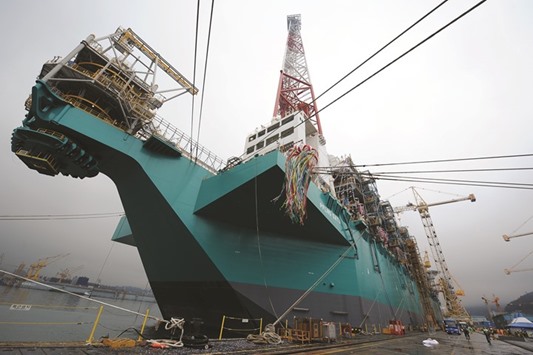It’s longer than three soccer fields, heavier than two aircraft carriers and powerful enough to chill gas into liquid colder than the surface of Jupiter.
And its maiden voyage couldn’t have come at a worse time.
The world’s first modern vessel for producing liquefied natural gas was ordered by Petroliam Nasional in 2012 when LNG traded for more than $15 per million British thermal units. It was launched last month, with prices down by about two-thirds. Royal Dutch Shell faces a similar problem with its version of a floating LNG plant, which will be larger than any ship ever built.
“At $15 and above you can do anything, so everyone went and did everything,” said Trevor Sikorski, a natural gas analyst for Energy Aspects in London. “Now all these projects start to come online at the same time, and all of a sudden you have all this supply and now your margins are next to nothing.”
The plight of the PFLNG Satu, as the first vessel is known, reflects the larger struggle facing all producers. Projects approved years ago when energy prices were high are coming online now, adding to a global supply glut that has pushed spot LNG down to $4.62 per million Btu this week.
Annual LNG demand is forecast to increase by 140bn cubic meters (5tn cubic feet) from 2015 through 2021, which isn’t enough to absorb almost 190bn cubic metres of new capacity slated to become operational, the International Energy Agency said in its Medium-Term Gas Market Report 2016 published on Wednesday.
“LNG projects take four to five years to get delivered,” said Prasanth Kakaraparth, Wood Mackenzie’s LNG supply analyst for Southeast Asia. “By the very nature of these long delivery periods, they get hit quite a bit by these commodity cycles.”
Petronas, Malaysia’s state-owned energy company, is betting the cycles will even out over the long run. PFLNG Satu will produce about 1.2mn tonnes of LNG annually for the next 20 years from the Kanowit gas field, which is located about 180km (112 miles) north of the coast of Borneo.
“We are taking a long-term view for this project,” Petronas said in a written statement. “In terms of profitability, the project is still viable as an additional supply point within our larger portfolio of LNG assets.” Floating LNG has some advantages over land-based liquefaction, Rafael McDonald, the Cambridge, Massachusetts-based global director of gas and LNG for HIS. It eliminates the need for pipelines to connect far-flung fields to shore. Companies also hope that they can better control costs in a shipyard than on a distant construction site, he said.
Putting production on the water isn’t a new idea in the LNG world. In fact, it’s the original idea. The first plant to chill natural gas for transport was mounted on a barge in a Mississippi shipyard in 1954, according to an account from Cedomir “Cheddy” M Sliepcevich, a chemical engineer instrumental in the birth of the industry. The barge, which was to liquefy gas for shipment to the Chicago Stock Yards, couldn’t operate economically, and the LNG industry moved on shore for the next 60 years.
The modern LNG movement began in 2011. Crude oil rose back to $100 for the first time since the recession, and the Fukushima nuclear disaster led Japan to shut its nuclear power plants and increase LNG imports for gas-fuelled power generation. The fuel in Japan rose from $11 per million Btu at the start of 2011 to nearly $17 by the end.
Shell approved its facility, called Prelude, in May 2011. The platform will produce three times as much LNG as Satu and also extract condensate, an ultra-light form of crude oil, and liquefied petroleum gases. Shell says it’s not technically a ship because it won’t propel itself between destinations. Prelude is expected to be generating “material” cash by 2018, Shell chief executive officer Ben Van Beurden said in April.
Current prices have dampened demand for floating LNG projects. Petronas has delayed its second floating liquefaction plant by two years. The ship had its keel-laying ceremony at a South Korean shipyard at the end of April and is expected to be operating by 2020. Colombia’s Pacific Exploration & Production Corp terminated in March a contract to lease a floating liquefaction facility from Exmar. Shell, Woodside Petroleum Ltd and other partners in March shelved a $40bn project in western Australia.
“The fact that we have not gone ahead with that project at this stage as a consortium doesn’t mean the concept of floating LNG doesn’t work,” Van Beurden said at a conference in Perth in April. “It does mean that the commodity cycle makes projects of that scale and investment level uninvestable at this point in time.”

The plight of the PFLNG Satu reflects the larger struggle facing all producers. Projects approved years ago when energy prices were high are coming online now, adding to a global supply glut that has pushed spot LNG down to $4.62 per million Btu this week.


